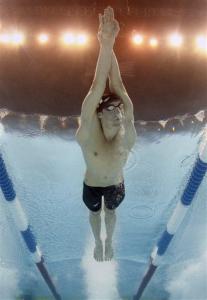 My principal area of research is the physics of locomotion on small scales; in particular, how bacteria swim using flagella.
My principal area of research is the physics of locomotion on small scales; in particular, how bacteria swim using flagella.
Most bacteria live in water, and many bacteria can swim through water, but the strategies that they use to to swim are very different from the ones we use. A “large” organism (such as a human) makes a stroke which accelerates him, producing a reserve of forward momentum. He coasts forward for a substantial distance (usually a few body lengths), gradually dissipating this momentum, while
 In his famous lecture Life at Low Reynolds Number, E.M. Purcell pointed out that much of biology occurs in this slow, small, viscous regime, and that the rules for locomotion at low Reynolds number are very different from the ones to which we are accustomed. Michael Phelps can swim with a simple scissor kick, but if he were 1000x smaller or swimming in goop 1000x more viscous than water, he would not move at all. As Purcell points out, the “Scallop Theorem” says that no purely symmetric stroke can propel a bacterium. This theorem is still the subject of active research today, earning Ed Cussler of U. Minnesota a coveted Ig Nobel prize in 2005. preparing for the next stroke. The swimming stroke is a cyclical pattern that delivers power to the swimmer in spurts; Phelps accelerates until the average power he delivers during a stroke equals his average frictional drag through the water. In contrast, if a bacterium stopped swimming it would stop moving almost instantly. A 1 µm long bacterium would coast only a few Ångstroms before stopping: less than a thousandth of a body length. Since it can’t build up a reserve of momentum, its power input and frictional drag must balance at every instant – not just over the long term. This general point was made more than a century ago, but is becoming more experimentally relevant with the development of ways to measure very small forces and distances. Slow swimming of a small object in a viscous medium corresponds to small values of the Reynolds number: a dimensionless number that quantifies the relative contributions of viscous and inertial forces to locomotion.
In his famous lecture Life at Low Reynolds Number, E.M. Purcell pointed out that much of biology occurs in this slow, small, viscous regime, and that the rules for locomotion at low Reynolds number are very different from the ones to which we are accustomed. Michael Phelps can swim with a simple scissor kick, but if he were 1000x smaller or swimming in goop 1000x more viscous than water, he would not move at all. As Purcell points out, the “Scallop Theorem” says that no purely symmetric stroke can propel a bacterium. This theorem is still the subject of active research today, earning Ed Cussler of U. Minnesota a coveted Ig Nobel prize in 2005. preparing for the next stroke. The swimming stroke is a cyclical pattern that delivers power to the swimmer in spurts; Phelps accelerates until the average power he delivers during a stroke equals his average frictional drag through the water. In contrast, if a bacterium stopped swimming it would stop moving almost instantly. A 1 µm long bacterium would coast only a few Ångstroms before stopping: less than a thousandth of a body length. Since it can’t build up a reserve of momentum, its power input and frictional drag must balance at every instant – not just over the long term. This general point was made more than a century ago, but is becoming more experimentally relevant with the development of ways to measure very small forces and distances. Slow swimming of a small object in a viscous medium corresponds to small values of the Reynolds number: a dimensionless number that quantifies the relative contributions of viscous and inertial forces to locomotion.
 I am interested in swimming and swarming, and how the physical properties of bacterial flagella enable these phenomena. I work on peritrichously flagellated bacteria like Escherichia coli – bacteria with many flagella randomly distributed over their surface. However, there are other ways to organize flagella. Some bacteria have a tuft of flagella at one or both ends, and some have a single flagellum at one end. There are weird exceptions such as the spirochetes – helical bacteria with completely internal flagella. Ultimately, I would like to understand why different bacteria have different kinds of flagellation: what properties of the different modes of flagellation make one better suited to a particular type of bacterial lifestyle.
I am interested in swimming and swarming, and how the physical properties of bacterial flagella enable these phenomena. I work on peritrichously flagellated bacteria like Escherichia coli – bacteria with many flagella randomly distributed over their surface. However, there are other ways to organize flagella. Some bacteria have a tuft of flagella at one or both ends, and some have a single flagellum at one end. There are weird exceptions such as the spirochetes – helical bacteria with completely internal flagella. Ultimately, I would like to understand why different bacteria have different kinds of flagellation: what properties of the different modes of flagellation make one better suited to a particular type of bacterial lifestyle.
